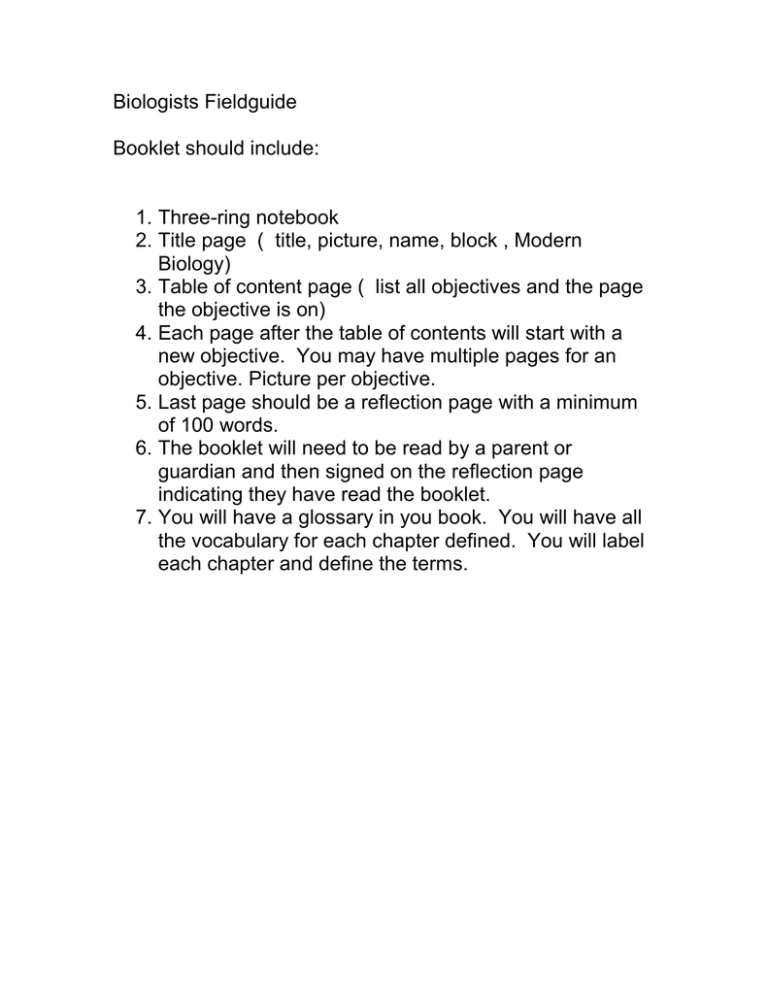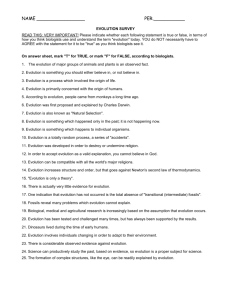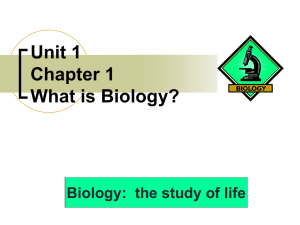Biologists Field Guide - Waukee Community School District Blogs
advertisement

Biologists Fieldguide Booklet should include: 1. Three-ring notebook 2. Title page ( title, picture, name, block , Modern Biology) 3. Table of content page ( list all objectives and the page the objective is on) 4. Each page after the table of contents will start with a new objective. You may have multiple pages for an objective. Picture per objective. 5. Last page should be a reflection page with a minimum of 100 words. 6. The booklet will need to be read by a parent or guardian and then signed on the reflection page indicating they have read the booklet. 7. You will have a glossary in you book. You will have all the vocabulary for each chapter defined. You will label each chapter and define the terms. Biologists Field Guide Chapter 1 The Science of Life Section 1-1: Themes of biology (pages 4-9) Objectives: 1. List the characteristics of living things. 2. Summarize the hierarchy of organization within complex multicellular organisms. _________ Section 1-2: Objective: Themes of Biology (pages 10-13) 1. Identify three important themes that help explain the living world. __________ Section 1-3: The Study of Biology (pages 13-19) Objectives: 1. Outline the main steps in the scientific method. 2. List the elements of a controlled experiment.(control group, experimental group, independent variable, dependent variable, qualitative observation, quantatative observation) 3. State how communication in science helps prevent dishonesty and bias. ____/15 ___________ Section 1-4: Tools and Techniques Objectives: (pages 21-24) 1. List the function of each of the four major parts of a compound light microscope. 2. Compare two kinds of electrons microscopes. 3. Give real life examples of the prefixes listed in table 1-2. Biologists Field Guide Chapter 2 Chemistry of Life Section 2-1: Composition of Matter (pages 31-34) Objectives: 1. Explain the relationship between elements, atoms, compounds, molecules. 2. Draw and label a model of the structure of an atom. 3. Draw a model of a covalent bonding and ionic bonding. _________ Section 2-2: Objectives: Energy (pages 35-37) 1. Draw the physical properties of each state of matter. 2. Draw an example of a chemical reaction and indicate the reactants and products in chemical reactions. 3. Explain the relationship between enzymes and activation energy. 4. Explain how oxidation and reduction reactions are linked. __________ Section 2-3: Solutions Objectives: 1. 2. 3. 4. 5. (pages 39-44) Draw the structure of a water molecule describe why the molecule is polar. Explain how water’s polar nature affects its ability to dissolve substances. Identify the roles of solutes, solvents, solutions and concentration. What are the properties of acids and bases. Draw a pH scale and show how to find H3O ion concentrations. Biologists Field Guide Chapter 3 Biochemistry Section 3-1: Objective: Water (pages 51-54) 1. Distinguish between organic and inorganic compounds. 2. Show why carbon forms so many different bonds in biological molecules. 4. Demostrate how condensation reactions and hydrolysis work in forming large and small molecules. 5. Show and describe how the breaking down of ATP supplies energy to drive chemical reactions. _________ Section 3-2: Objectives: Molecules of Life (pages 55-60) 1. Distinguish between monosaccharides, disaccharides, and polysaccharides. 2. Explain the relationship between amino acids, and protein structure. 3. Describe the induced fit model of enzyme action. 4. Compare the structure and function of each of the different types of lipids. (fatty acids, triglycerides, phospholipids, waxes, steriods) 5. Compare the nucleic acids DNA and RNA. Biologists Field Guide Chapter 4 Cell Structure and Function Section 4-1: Objective: The History of Cell Biology (pages 69-71) 1. Name and show what Hooke and Leeuwenhoeks observed nonliving and living cells. 2. State the three principles of the cell theory. _________ Section 4-2: Objectives: Introduction to Cells (pages 72-76) 1. 2. 3. 4. 5. Explain the relationship between cell shape and cell function. Identify the factor that limits cell size. Describe the three basic parts of a cell. Compare prokayotic cells and eukayotic cells. Analyze the relationship among cells, tissues, organs, organ systems, and organisms. __________ Section 4-3: Cell Organelles and Features (pages 77-85) Objectives: 1. Describe the structure and function of a cell’s plama membrane. 2. Drawthe major organelles found in the cytosol, and describe their roles. (nucleus,mitochondria,ER, Golgi appartus,lysosomes, cilia and flagella) ___________ Section 4-4: Unique Features of Plant Cells (pages 87-90) Objectives: 1. Explain the role of the central vacouole. 2. Describe the roles of plastids in the life of a plant. (chloroplasts, chromoplasts) Biologists Field Guide Chapter 5 Homeostasis and Cell Transport Section 5-1: Objectives: Passive Transport (pages 97-102) 1. Show how an equilibirum is established as a result of diffusion. 2. Distinguish between diffusion and osmosis. 3. Show how substances cross the cell membrane through facilitated diffusion. _________ Section 5-2: Objectives: Active Transport (pages 103-106) 1. Distinguish between passive transport and active transport. 2. Expalin how the sodium-potassium pump operates. 3. Compare endocytosis and exocytosis. Biologists Field Guide Chapter 6 Photosynthesis Objectives: 1. Draw a diagram of a chloroplast and label the structures in a chloroplast. 2. Show light reation and dark reaction 3. Show the chemical equation for photosynthesis. Chapter 7 Cell Respiration Objective: 1. Draw aerobic and anaerobic respiration. 2. Summerize glycolysis, pyruvic acid breakdown, Kreb’s cycle, and E.T.C.) Biologists Field Guide Chapter 8 Cell Reproduction Section 8-1: Objective: Chromosomes (pages 151-153) 1. Describe the structure of a chromosome. 2. Identify the differences in structure between prokayotic chromosomes and eukaryotic chromosomes. 3. Explain the difference between sex chromosmes and autosomes. 4. Distinguish between diploid and haploid cells. _________ Section 8-2: Cell Division (Mitosis) (pages 154-159) Objectives: 1. Draw and describe the events of cell division in eukayotes.(phases of mitosis) 2. Compare cytokinesis in animal cells with cytokinesis in plant cells. 3. What is cancer? __________ Section 8-3: Meiosis (pages 161-164) Objectives: 1. Compare the end products of meiosis with those of mitosis. 2. Explain crossing-over and how it contributes to the production of unique individuals. 3. Compare spermatogenesis and oogenesis. Biologists Field Guide Chapter 10 DNA,RNA, and Protein Synthesis Section 10-1: Discovery of DNA (pages 193-195) Objective: None You are just expected to read about the experiments that led to the dicovery of DNA. _________ Section 10-2: DNA Structure (pages 96-199) Objectives: 1. Evaluate the contributions of Franklin and Wilkins in helping Watson and Crick discover DNA’s double Helix structure. 2. Describe the three parts of a nucleotide.. 3. Relate the role of the base-pairing rules to the structure of DNA. __________ Section 10-3: DNA Replication (pages 200-202) Objectives: 1. Summarize the process of DNA replication. (helicase, polymerase) Section 10-4: Protein Synthesis (pages 204-210) Objectives: 1. Compare the structure of RNA with that of DNA. 2. Compare the role of mRNA, rRNA, and tRNA in translation. 3. What is the human genome?




